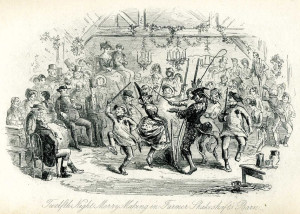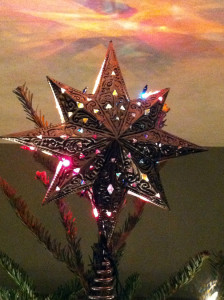Holiday confession time: When the Advent season arrives as early as it did this year, which basically stems from Christmas itself falling on a Sunday, I have a harder time than usual transitioning into the Christmas spirit. We’re already past the Second Sunday of Advent (it was yesterday) and still you’ll find dried corn hanging on our front door and orange lights strung on our bookcase. Though we’ve been opening the windows on our advent calendar, we had to catch up the first couple of days because we didn’t have a calendar chosen on the First. And life’s been so busy, Seth and I have ourselves quite a lot of catching up to do on our advent candles.
Ah, but tonight comes St. Nicholas’ Eve, and with this night, we welcome the first of the Midwinter gift bearers, wending his way through the midwinter darkness. Advent and Christmas suddenly seem more tangible, more real. On years like this, St. Nicholas serves as my reality check.
Although Santa Claus is a super big deal here in the States, and though we often call him Old St. Nick, the real St. Nicholas barely earns a blink of anyone’s eyes here. But there are other parts of the world, especially throughout Europe, where this is a very important night indeed. It is the Eve of St. Nicholas (St. Nicholas’s Day being tomorrow, the 6th of December), and children there will place their shoes by the chimney before going to bed in hopes that St. Nicholas will fill them with gifts. They’ll set out carrots and hay for his donkey.
In these overnight hours, the old bishop will make his rounds. Good children might wake up on St. Nicholas’ Day to find their shoes filled with fruits and nuts and sweets and small toys. But St. Nicholas does not wander alone; he travels tonight with a dark companion. The companion goes by many names, depending on the region––Knecht Ruprecht, Black Peter, Pelznickel… but he is best known as Krampus: half man, half goat, a bit terrifying… the punisher of children who have been naughty. These two are not as secretive as our American Santa. There are parades this time of year throughout Europe for St. Nicholas’ Day and Krampus pretty much steals the show at some of these parades, especially in parts of Germany, where tonight is known as Krampusnacht.
I love the time of the Midwinter gift bearers. Such a beautiful way to make the Midwinter darkness less… dark (despite Krampus). St. Nicholas will be followed over the next few weeks by the Christkindl, by Santa Lucia, by Father Christmas and Santa Claus, by los Tres Reyes (the Three Kings) and a kind old witch named Befana who will sweep away the remnants of the Christmas season in early January.
But that’s all a long ways away. For us tonight here in this little old house in Lake Worth, we will leave our shoes by the bed, which we always do. Our small old home has small old closets, and so we almost always have a couple of pairs of shoes outside the closet––there’s just no place in the closet to put them. I don’t know if St. Nicholas and Krampus will make their way this far from Europe, but chances are good that once we go to bed, Haden the Convivio shop cat will spend some time hunting down her little stuffed animal toys, carrying them about and making the odd cries that cats make once they have caught their quarry, and maybe tonight she will drop one of them into someone’s shoe, as she is wont to do so many nights. But before those magic overnight hours, we will brew ourselves some tea, or maybe some mulled wine, and we will for sure open a package of Steenstra’s St. Claus cookies. The cookies are speculaas, a type of Dutch cookie made for St. Nicholas’ Eve. They sell them all year long at the Publix bakery in a small cellophane-wrapped package. The cellophane is clear and the box inside is bright orange. The Steenstra family emigrated from the Netherlands to Michigan in 1926, and that’s where the cookies are still made, as they have been for about 90 years now. They taste of almond and warm spices like ginger and clove, and they depict five different scenes about St. Claus (more correctly about St. Nicholas of Myra, the kind fourth century bishop who gave gifts to the poor while they slept). There is St. Claus on a horse (a derivation of that donkey), a boy and a girl (because they like to receive presents from St. Claus), a rooster (because St. Claus starts his day at sunup), an owl (because St. Claus works til sundown), and a windmill (because St. Claus lives in a windmill). The first of the gift bearers gives us reason to celebrate tonight; we hope you’ll join us in that.
Image: Our Steenstra’s speculaas, ready to go. Just have to mull that wine now.


